

If you are new to alpacas where do you start?
Well firstly let me say, welcome to the wonderful world of alpacas! From here on in we will take you on a basic tour of all things alpaca, and along the way hopefully provide answers to some of the questions you may have in your mind & maybe some that you didn’t even know you needed to ask.
We will actually tell you things that you need to know to avoid any pitfalls that may await the newcomer to this industry. We base our business on an honest upfront approach to providing people with all the information they need to make informed decisions.
We hear too many stories about people buying alpacas for the first time & not being given even the most basic information about the animals they are purchasing. Would you buy a car without asking if it were manual or automatic, petrol or diesel, roadworthy & registered etc etc etc ? Well alpacas are no different in regards to asking the right questions to ascertain the quality of what you are buying. I hear you say “how do I know what questions to ask?”, well we know that you can’t be expected to have that knowledge at the beginning, so we are about letting you know what to ask & why you need to ask it!
We know at first that it can seem confusing, where do you start with all this industry jargon about fleece & bloodlines? Take the time to read this page, it could save you both money & time in the long run. Knowledge is the key to success in this industry, don’t be daunted by it, we encourage you to take every opportunity to learn as much as you can whenever the opportunity arises.
So lets get started! The absolute basics are:
Essential Basic Husbandry
1. Shearing -
2. 5 in 1 vaccination every 6 months to protect against tetanus & other diseases. Also a vitamin D injection (in the form of ADE) late Autumn to protect against rickets
3. Toenail trims as required
4. Access to clean water and shade ALWAYS
5. Access to pasture adequate to sustain them and hay/alpaca pellets when not like during drought and in Winter.
6. Test for worms and treat if required, check for injury, eye problems etc regularly to keep animals healthy.
7. Be able to separate intact males or recently castrated mature males from females or they will harass the pregnant females which can cause stress and sometimes make them abort.
If you don’t want to do any of the above -
Buying Alpacas
Assuming you are good with the alpaca husbandry requirements you will find there is a lot more to buying alpacas than just buying the first one you see. Of course all alpacas need to be in good health and correct confirmation is also an important quality to look for when buying.
There are 2 types of alpaca:
Huacaya -
Suri -
Colour -
Guidelines – 3 Steps to Follow
1. Ask yourself, why do I want alpacas?
Before getting started you need to sort out why you want alpacas, there are 3 main reasons people own alpacas:
Pets/Lawn Mowers -
You must get them wethered by the vet at between approx. 12-
Older non breeding females are often affordable & can also make good pets.
PRICE: Expect to pay from $250 each for multiple purchases of young unwethered males/non breeding females.
Herd Guardians -
PRICE: Expect to pay from $300 each for individual wethered males, up to $500 if they have proven guarding experience & prices for females vary.
Breeding Alpacas -
Only buy AAA (Australian Alpaca Association) registered alpacas for breeding if you want to have a good market for your future alpaca sales, and very importantly don’t want to inadvertently mate alpacas that are too closely related and end up with potentially deformed baby cria!! If you don’t know the animals genetics then how can you know what you are breeding?
PRICE: You can get older lower quality females for under $1000, but expect to pay from $1000 for average breeding females. Some nice quality females will cost from about $2500 to many thousands.
Stud males can be a large investment, we suggest you wait a few years when you have more experience before you buy your own.
PLEASE NOTE: These prices are given as a guide but there are always exceptions to the rule & these are the prices we charge. We believe the prices quoted are going to give you a guideline that won’t see you pay too much, however keep in mind that other studs have their own pricing system & each animal has to be assessed on an individual basis.
2. What do I want to achieve?
This question is vitally important if you choose to breed alpacas. The earlier you decide on what you want to breed toward then the better off & more successful you will be, & you will save yourself years of time wasted in going nowhere fast!
NOTE: You will achieve more improvement faster if you concentrate on a few traits rather than a mix of many. For example we concentrate on breeding for white & fawn ultrafine huacaya that stay fine over time.
Decide on what type, huacaya or suri or maybe both.
Which colour or colours do you want to breed for.
What fleece traits do you want to aim for.
Once you have a breeding plan in place it will make purchasing your alpacas much easier & less confusing. Alpacas are fleece producing animals, so their value is determined by the quality of their fleece & the ability to pass on those fleece traits to their offspring.
So what makes a good fleece – the big question!
Depending on what alpaca stud you talk to, you may get a variety of answers to this question. These are the fleece need to knows:
Statistics– we believe too many people sell animals without any history of the animals fleece statistics, nobody can guarantee you what micron an animal is without testing the fleece. Beware of alpacas described only as having a ‘soft handling fleece’, as soft handle is a characteristic of alpaca fleece anyway & some may call an animal fine which others think is too coarse.
Fleece tests are normally done once a year around shearing time & are sent away to a testing company. They then send you the results in the form of a chart called a histogram.
Statistics will tell you these things:
Micron– How fine a fleece is falls into these categories:
Ultrafine -
Superfine -
Fine -
Medium -
Strong -
Very Strong -
We aim for all cria to have a first fleece under 19 micron.
The longer they stay under 20 micron the better as most alpacas tend to ‘blow out’ or increase in micron as they age. Animals staying under 20 micron for many years are not that easy to find. Also look for animals that don’t move much on their micron from year to year, an alpaca that started at 20 micron & only moved to 22 micron in 5 years, is much better in regards to ‘blow out’ than one that started at 17 micron and jumped to 27 micron in 5 years for example.
At the finer end of the scale a few micron can make the difference between getting $70 a kilo (ultrafine) to $12.10 a kilo (fine) for your fleece. But micron alone is not the only factor to consider.(Based on recent prices paid).
Fleece tests are usually taken from a mid side sample, but grid tests taken from several samples from throughout the fleece give a better indication if the fleece is consistent in micron throughout.
SD (Standard Deviation) -
SD is very important & tells you the number of micron variation away from the average micron, that was found in a set percentage of fibres in a given fleece sample. Confusing?
Think of it this way, the best ultrafine Merinos have SD’s down to 2, alpacas have a long way to go to catch up with the decades of selective breeding put into the merino. But alpacas with SD’s under 4 are excellent, under 5 good, over 5.0 getting a bit high for our liking. Our best Alpaca SD to date for an adult has been 2.8 (at 2 years old) with a herd average each year around 3.7 for our adults.
The lower the SD the more even the fleece in micron which is what you should be aiming for.
CV (Coefficient of variant) -
You take the SD divided by the micron & times it by 100.
EG: SD 4 ÷ Micron 18 x 100 = CV of 22.2
Some people think that a low CV around 20 or less indicates a good fleece, but quite often a low CV can hide a high micron.
EG: SD 5 ÷ Micron 30 x 100 = CV of 16.6.
CV doesn’t exist without SD & Micron, so always ask for the full set of stats not just CV.
CV is useful when you are comparing alpacas of the same micron, not a variety of microns which most alpaca herds consist of.
CF (Comfort Factor) -
This relates to how a fleece feels against the skin, it is indicated by a percentage, the closer to 100% being the best which indicates the sample had no fibres over 30 microns, as it it these course fibres that cause prickle. Good CF is 90+%.
Visual Fleece Inspection
Many important characteristics of fleece can be best ascertained by visual inspection.
Crimp & Bundling
Crimp can be measured by how many times the fleece crimps per inch in it’s relaxed state. A broad crimp would be about 3 to 4 crimps per inch, an average crimp about 5 to 7 crimps per inch & a high frequency crimp about 8+ crimps per inch. Crimp style comes down to personal taste as processors prefer some crimp but are not overly concerned with how much. As a general rule the alpaca industry prefers a higher rather than lower crimp frequency.
The amplitude of crimp refers to the distance in any given crimp between it’s peak & it’s trough. A high amplitude crimp appears crisper & more defined & is preferred by the industry.
A fleece should also open cleanly without ‘cob webbing’, it is preferred if it falls into staples or bundles like lots of individual fingers, the thinner the staple the better.
Density
Density refers to the amount of fleece follicles on an animal which can often be felt as resistance to the pressure of your hand when touching the fleece.
The easiest way to know if an animal is cutting more fleece is simply to weigh the fleece after shearing. After all, it’s fleece weight that determines how many kilos you will be paid for.
The finer the animal then quite often the lower the fleece weight.
Adult alpacas cutting 1 kilo of useable 25 micron fleece is not good, but 1 kilo of lighter weight 15 micron fleece is quite acceptable. On average, adult alpacas should cut from 1 kilo to about 2.5 kilos if their micron is ultra fine to fine, courser fibre weighs much more so should cut higher fleece weights in general.
But beware of falling into the trap of the allure of a high fleece weight over all else. As 5 kilos of medium micron fleece will not make as much money as just 1 kilo of ultra fine fleece.
So you can see, density is important as long as the fleece is fine enough to be of reasonable value.
Length – the length of the fleece measured from skin to tip
Those who process alpaca fleece prefer a length between approx. 75mm to 100mm as they often blend alpaca with merino & they have machinery set up for this fleece length. Over long fleece above 120mm is not suitable for commercial production but can be good for hand spinners.
Lustre– How shiny the fleece is
Lustre is a visually measured trait & is highly desirable in the industry & can also be an indicator of healthy well nourished fleece.
3. How?
Finally we come to how will you achieve your goals?
You will need to consider your budget, if you want to get as many animals as quickly as possible then buy lower quality girls put to good males. Package deals are often a cost effective way to get started. Ask studs if they can offer you a package which can often include a pregnant female with female cria at foot (called a 3 in 1 package) or several pregnant females with free remates etc.
If quality is more important than quantity buy the best girls you can afford & put them to excellent males. But remember that a $6000 female still only gives you one baby (cria) a year, so it may take some time to see any return through animal sales.
Before you buy
Try to talk to as many breeders as you can, visit different studs & web sites & see what they have to say (or sometimes what they don’t say is just as important). Ask lots of questions & avoid breeders that can’t answer them to your satisfaction.
Remember, nothing is set in stone. Even though most breeders are striving to breed the perfect alpaca, they often approach it from different angles, what is important is that they can explain why & how they make their breeding decisions. A breeder without a breeding plan is like a car without a steering wheel, the quality of their alpacas could end up anywhere!
This has been a general overview of alpacas & is based on our own experiences & beliefs. We have been involved within our industry in running the ‘National Alpaca Fibre Seminars’ & producing the Ultrafine & Superfine fleece bales which set an Australian record for fine alpaca fibre. We have also been involved with running the Far South Coast National Alpaca Show at Bega NSW.
We are passionate about alpacas & their wonderful fleece, we hope you will also experience the joy of alpaca ownership & the satisfaction that comes with seeing your dreams becomes reality.
We offer a variety of alpaca workshops for those interested in learning more & having a hands on experience.
Getting Started In Alpacas
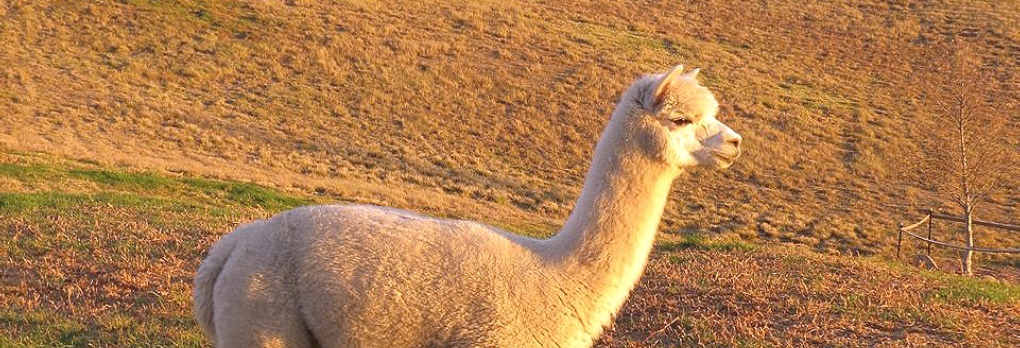
Starting In Alpacas E-Book
Oak Grove Alpacas offers this E-
It is a basic guide for the new or would be alpaca owner, covering topics from how to select alpacas, fencing, husbandry, shearing, farm set up, feeding, breeding & much more.
It offers more in depth information than is offered on our website. Only $5.50AUD
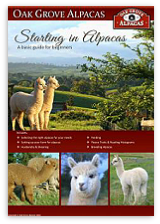





In A Hurry? The Quick Crash Course





What others are saying about us





I have begun researching Alpacas and have found the information on your website most interesting. I am a teacher so this would be a very big lifestyle change for me but I have always enjoyed my animals and plants and would enjoy a new challenge! I would love to chat with you further to share your amazing Alpaca experience.
Michelle B -





I have been reading your website and have found it to be most educational thank you.
Jane W -





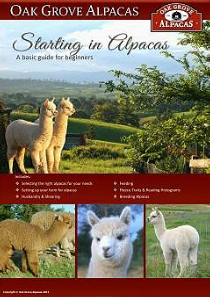
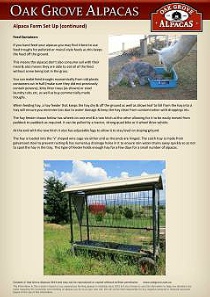
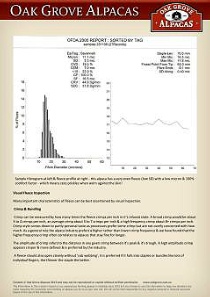
Sample Pages
Please read our Our Privacy Policy for detailed information on how we use any information you provide to us via this website..





Are Show Ribbons Important?
Yes, they can indicate that an animal was of a sufficient standard to be awarded a prize at that show, under that judge, on that day.The same animal may not even win a place at a show the very next week. It all depends on the judges opinion, and the quality of the competition on the day etc.
Consistent wins at multiple shows are a better indication that an animal is a worthy prize winner.
In general a show ribbon is awarded on style of fleece & the animals conformation.
Commercial fleece is a different thing as it is based more on what fleece will give you the best financial return. Quite often a supreme champion animal may have a fleece only worth $30, but another that didn’t get placed have a fleece worth $120.
Just be aware of the differences & keep things in perspective.
We believe this is essentially a fleece industry & that all shows should at least test fleeces in the shorn fleece classes
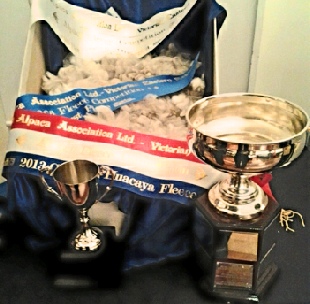

Essential information you should know before you buy.
No matter which alpaca breeding stud you visit, it is essential to understand what you are looking for & why.
Steps to follow:
Determine why you want alpacas? This will determine what type, quality & sex of alpacas you buy.
If you just want pets, then colour & fleece quality are not important unless you want to have the fleece spun to knit or weave.
If you want to breed alpacas, then buy the best you can afford or if your priority is to get numbers on the ground, then buy cheaper females & put them to good males to improve your quality.
Alpaca Husbandry
Shearing -
Vaccinations -
Toe Nail Trim -
Worms -
Shade/Shelter -
Water -
We provide more details of how to go about these husbandry tasks, vaccination dosages etc in our E-
What makes a good alpaca?
Good confirmation is important.
Fleece quality or it’s ability to produce progeny with good fleece is the main determining factor of an animals value.
Always ask to see fleece statistics (histograms) over several years to see what the fleece is doing. Beware of studs that don’t have regular fleece statistics on adult animals & especially current stats for stud males.
Some of what a histogram tells you.
A histogram is the name of the type of fleece test taken.
Micron: The measurement of how fine a fleece is.
We aim for all cria to be under 19 micron.
All adults to be under 25 micron at 5 years old.
Look for alpacas that stay fine for longer. Avoid animals that have a high micron on their first fleece.
SD-
Under 4 is good.
Over 5.0 especially in younger animals we believe is getting a bit high.
CF-
Other things a histogram can’t tell you.
Crimp
No crimp is not desireable.
The more times the fleece crimps per inch the better, low is 3 & high is 8+.
Crimp Amplitude is how defined the crimp is, with the greater the distance between the peak & trough of the crimp the better.
Fleece weight– average fleece weights vary & can be affected by fineness & density.
High fleece weight is important as long as it’s also fine enough to be of value.
Whole Body Fleece weights
Adults Under 1kg -
2kg -
3kg -
4kg -
5+kg -
Before wanting to purchase alpacas I came across the Oak Grove Alpacas workshop. Julie was very accommodating and tailored the 2 day workshop so it covered absolutely everything I needed to know about raising alpacas, right through to the business end of things. The hands-
Danielle J. NSW -
I just wanted to send you a quick note to say thank you for the write up in the Starting in Alpacas section you have on your website.
After spending to much time trying to get as much information as I could on starting up with Alpacas, I finally came across your website which answered all my questions and now I also finally understand the Alpaca Fibre Analysis reports I received with my Alpacas.
Again thank you so much in helping to get my head around everything.
Barbara G -







Copyright © Oak Grove Alpacas
Contact Us
Web Design by Oak Grove Graphics

| Females For Sale |
| Potential Stud Males |
| Pets & Herd Guard Alpacas |
| Fleece For Sale |
| Ultrafine Fleece |
| Workshops |
| Articles |